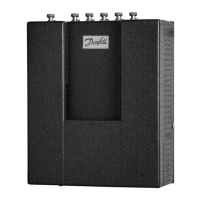© Danfoss | 2021.06| 25LGB40450
Termix VVX-I-R FI - 7 Series DS fully insulated
DHW Temperature control
DHW temperature control
There are various types of DHW temperature control used in Danfoss
heat interface units.
DHW temperature should typically be adjusted to 45-50 °C, as this
provides optimal utilisation of DH water. At DHW temperatures above
55 °C, the possibility of limescale deposits increases significantly.
IHPT 180 controller (45-65°C)
The IHPT 180 controller is a self-acting flow-compensated temperature
controller with integrated differential pressure controller.
By turning the handle for temperature setting in a (+) direction the setting
is increased, and by turning it in a (-) direction the setting is decreased.
Turns* Scale DHW Temperature Settings (° C)
07 64
16 61
25 58
34 55
43 52
52 48
61 44
70 43
* Start position: Handle turned fully in (+) direction.
The values are intended as a guide. Typically best verified at the kitchen tap
74
see diagram
DHW Re-circulation
Circulation pipe
The circulation pipe set is mounted directly on the controller.
The set includes circulation pipe, single check valve and fitting.
When mounting the hot water circulation directly on the controller
the hot water circulation temperature will be the same as the idle
temperature. The idle temperature is a few degrees lower than
the set domestic hot water temperature.
Hot water recirculation pump
When a hot water recirculation pump is installed together with
the pre-payment unit, it is recommended that the pump takes
Switched Live from Terminal 2 in the heating interface wiring box.
This is to ensure that the pump stops circulating when no credit
is available on the pre-payment unit.
Pressure absorber
The pressure absorber reduces excess pressure created in the system
caused by sudden opening/closing of taps, so a discharge outlet
is omitted.
The pressure absorber can be used as a substitute to the safety valve.
By reducing such excess pressure, the pressure absorber ensures
proper functioning of the components located in the system.
It will also considerably reduce the noise generated by vibrations
that occur due to the sudden closure of taps. The pressure absorber
should not be applied in systems with hot water circulation.
74
see diagram
62
see diagram

